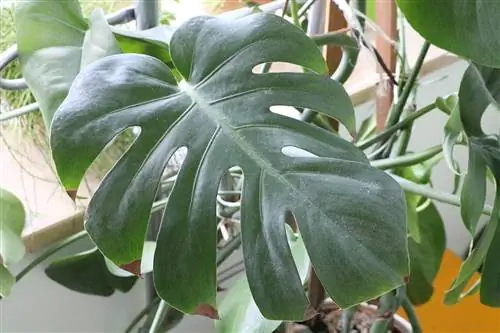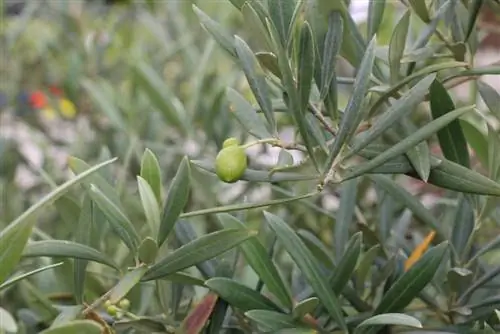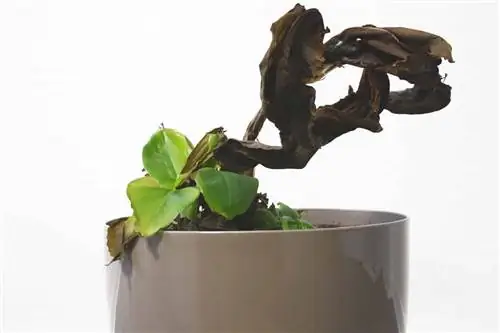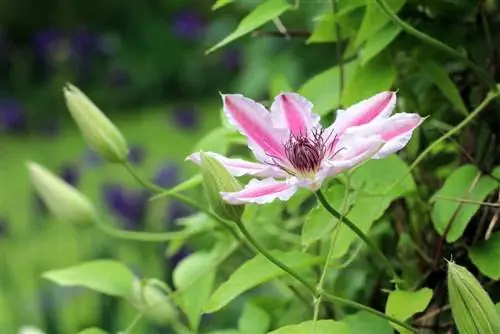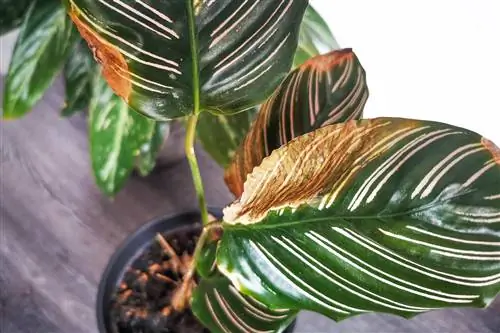- Author admin [email protected].
- Public 2023-12-17 03:39.
- Last modified 2025-06-01 06:48.
In this article you will find out possible causes for the discoloration of the Monstera, as well as helpful tips for treatment.
Avoid nutrient deficiency or excess
The Monstera has a moderately high nutrient requirement and should be fertilized regularly in a balanced amount. If it is not supplied with sufficient nutrients, the leaves change color and are ultimately dropped. Too well-intentioned fertilization also causes brown leaves, but also burns the roots. This is often the case, for example, when fertilizing with an undiluted liquid fertilizer. However, both a nutrient deficiency and an excess can be avoided by taking the following tips into account:
- Fertilize every 2 weeks from March to September
- Fertilizer sticks for green plants
- Or liquid fertilizer for green plants
- Mix fertilizer into the irrigation water
- Observe the manufacturer’s dosage
Optimize lighting conditions
The Monstera originally comes from the rainforest, where it grows in the shade of the canopies of large trees. Accordingly, it prefers bright locations and generally gets along quite well with less light. However, it doesn't tolerate places that are too dark, nor does it tolerate the blazing sun. If the window leaf is dissatisfied with the lighting conditions, this can often be recognized by brown or black spots on the leaves. To avoid this, the following should be taken into account regarding lighting conditions:
- Bright to sunny location
- Partially shaded location from June to September
- Avoid direct sunlight
- protect from midday sun
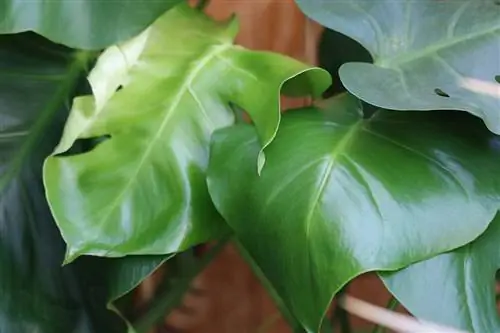
Very often, black or brown discoloration can be traced back to a lack of light. Especially in winter, many plants receive too little light. Even before brown spots form, a lack of light can be recognized by other features: On the one hand, the leaves are generally darker and, on the other hand, the indentations or notches in the leaves are only weakly or not at all pronounced.
Adjust air conditions
The optimal location for the Monstera is near a window, with an east, west or north window being best suited for this. In addition, care should be taken to ensure that the plant is not exposed to drafts. Humidity should also always be taken into account, as air that is too dry is not good for the window leaf and can cause brown discoloration. However, the optimal humidity can be achieved in just a few simple steps:
- Humidity between 60 - 70 percent
- Avoid dry heating air
- Set up an indoor fountain
- Mist the plant daily
Tip:
To check the humidity, it is worth using a humidifier or hygrometer!
Fight fungal infection
Brown or black spots on the leaves of the Monstera can also indicate eyespot disease (Spilocaea oleagina). This is a fungal infection that causes brownish to black spots to form on the leaves. The spots are round in shape, light brown on the inside and have a slightly darker edge. It is also typical that the remaining leaf often takes on a yellow color and later on it usually turns completely brown or black. If the fungal infection is not detected early, it can spread unhindered and cause great damage to the plant. To avoid this, action should be taken immediately in the event of an infestation:
- Remove affected leaves
- Cut with a sharp and disinfected cutting tool
- If the infestation is severe, cut the plant back completely
- Dispose of clippings in household waste
Note:
If there is an infestation, it is worth giving the weakened plant strengthening agents. Horseneck mud or liverwort extract are ideal for this.
Prevent waterlogging
Proper watering is not only crucial for the growth of the Monstera, because brownish orBlack discoloration can be avoided this way! The tropical plant wants to be watered regularly, but cannot tolerate waterlogging. The latter is very often caused by watering too frequently or using too much water. A blocked drain hole can also lead to waterlogging. If the excess water has already collected in the pot, you should act immediately and repot the plant:
- Removing the plant from the pot
- Remove wet soil
- Rush the roots with lukewarm water
- Checking the roots
- Remove brown and diseased roots
- Cleaning the planter
- Create drainage via drainage hole
- Fill the pot halfway with soil
- Place the plant in the middle and no deeper than before
- Don't water!
Tip:
Materials such as expanded clay, gravel or pottery shards are suitable for drainage.
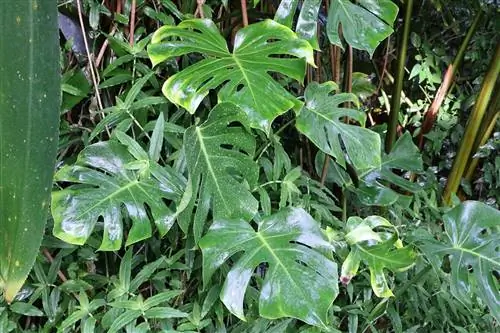
After repotting, the plant should not be watered immediately. Instead, it is advisable to wait around a week before dispensing water for the first time. It is then advisable to allow the soil surface to dry a little between watering. To avoid waterlogging in the future, excess irrigation water should always be removed.
Optimize temperature
In the South American rainforest, the Monstera enjoys a warm climate and prefers a constant temperature in the living room at home. She neither likes it when it is too cold nor can she tolerate temperature fluctuations. Because it reacts to both by forming brown or black spots. To avoid this, the optimal temperatures should always be present:
- April to September: 20 - 28 degrees Celsius
- October to March: 16 - 21 degrees Celsius
- Never permanently below 16 degrees Celsius!
Note:
The heat radiation from devices and radiators should not be underestimated!
Avoid water shortage
Brown spots can also be a sign of drought stress caused by a lack of water. In this case, the roots do not receive enough water, which affects both water and nutrient absorption. The leaves first turn yellow, then brown, before finally wilting and dying. You can determine whether the soil is moist enough using a moisture meter or finger test. If the soil is dry, the Monstera suffers from drought stress and should be watered immediately. It is even better to avoid a lack of water by taking into account the following when watering:
- Water abundantly in summer
- Water less in winter
- Keep substrate moist at all times
- Pay attention to high humidity
- If necessary, dip root ball in water
Note:
Very long aerial roots can be redirected into a container filled with water.

